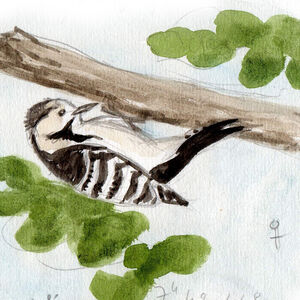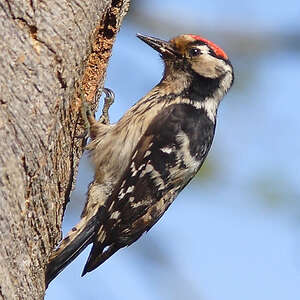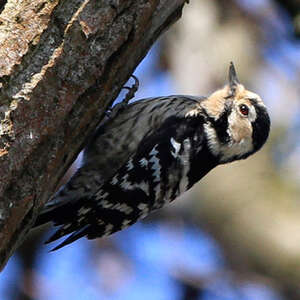Lesser Spotted Woodpecker
Dryobates minor - Pic épeichette
Identification
The Lesser Spotted Woodpecker is a small picid, the smallest of European woodpeckers. Its length is 15 cm and its weight 20-25 g, with small individual and subspecific variations. It is a Dryobates, and is closer in appearance to North American minor and hairy woodpeckers than to our European Great and Middle Spotted Woodpeckers, which are Dendrocopos. In addition to size, the absence of large white patches on the top and red under the tail distinguishes it from the latter species. The species shows a slight but distinct sexual dimorphism. The adult male has a red cap bordered by black. Red is absent in the female or reduced to small stripes. The juvenile is darker underneath as it has less distinct spots than the adult and sometimes a barred aspect on the sides. The cheeks are darkened. The young male has a clearly red cap while the young female has none or very little. The species shows 13 subspecies which differ only by physical or plumage details.
Subspecific information 13 subspecies
- Dryobates minor minor (Scandinavia and ne Poland to the Ural Mts.. Russia.)
- Dryobates minor comminutus (England and Wales)
- Dryobates minor kamtschatkensis (Ural Mts. to the Sea of Okhotsk and n Mongolia)
- Dryobates minor immaculatus (Anadyr Basin and Kamchatka Pen.. e Siberia)
- Dryobates minor amurensis (ne China, Siberia, Korea and Hokkaido. Japan.)
- Dryobates minor hortorum (c Europe)
- Dryobates minor buturlini (s Europe)
- Dryobates minor danfordi (c and e Greece and Turkey)
- Dryobates minor colchicus (Caucasus and Transcaucasia. sw Asia.)
- Dryobates minor quadrifasciatus (se Azerbaijan. sw Asia.)
- Dryobates minor hyrcanus (n Iran)
- Dryobates minor morgani (sw Iran)
- Dryobates minor ledouci (nw Africa)
Foreign names
- Pic épeichette,
- Pico menor,
- pica-pau-galego,
- Kleinspecht,
- kis fakopáncs,
- Kleine Bonte Specht,
- Picchio rosso minore,
- mindre hackspett,
- Dvergspett,
- ďateľ malý,
- strakapoud malý,
- Lille Flagspætte,
- pikkutikka,
- picot garser petit,
- Stubbspæta,
- dzięciołek,
- mazais dzenis,
- mali detel,
- Малый пёстрый дятел,
- コアカゲラ,
- 小斑啄木鸟,
- mindre hackspett,
- 小斑啄木,
Voice song and call
The Lesser Spotted Woodpecker is a discreet bird. If it were not for its voice and its drumming in the spring, it could easily go unnoticed and that is what it seeks since it is small and vulnerable. The usual broadcast, which could be called a song, consists of the monotonous repetition of high-pitched kji piercing sounds, around 10 or a little more: kji kji kji kji kji .... The drumming is typical. It is long, high and fast paced. All things considered, it is reminiscent of that of the black woodpecker. Both sexes beat the drum.
Habitat
The Lesser Spotted Woodpecker is found in Europe in plains or hillside deciduous forests. It prefers moist, soft-wood forests along streams and lakes, riparian woodlands, and wet woodlands. Old artificial woodlands such as poplar plantations or parks are also suitable habitats. These habitats are occupied year-round. In the Maghreb or Asia, it can go up to an altitude of 2,000m in the Caucasus, following the elevation of favorable woodlands.
Behaviour character trait
The Lesser Spotted Woodpecker is usually not very noticeable due to its size and discreet behaviour. It is usually its vocalizations that betray its presence.
It tends to frequent and exploit the upper parts of trees, much like tits, but with a more efficient beak to dislodge prey from under bark and in dead wood. As such, it does not compete with its larger, heavier congeners. The pair remains united throughout the year and is generally sedentary. Only birds from less favourable woods or harsher climates make some sort of movement.Flight
Dietfeeding habits
Due to its small size and reduced weight, the Lesser Spotted Woodpecker can exploit what is out of reach for other woodpeckers, namely the thin tips of the crowns in their dead or decaying parts.
Its sharp beak lends itself to softer kinds of wood, such as trembling aspen. It performs a search underneath the bark and in dead wood for its microfauna, xylophages and others, especially for forms of resistance to bad weather. Young ones are fed with the entomofauna. It is not particularly fond of seeds. Nevertheless, it may approach, in bad weather, winter feeding stations and take some seeds. However, it will be more interested in fat balls.Reproduction nesting
The Lesser Spotted Woodpecker pair remains together throughout the year, so finding a partner is not necessary for this species.
At the end of winter, however, sound and body language rituals will begin to strengthen the pairs bond and materialize their territory, which will be defended against intruders of the same species during breeding season. Like other family members, the Woodpecker makes its nest by chiseling a hole in the trunk or dead branch of a soft wood tree, such as a poplar or a willow. The entrance is circular and adapted to the small size of the birds. In late April or May, the female lays 5 to 6 eggs which she incubates for about two weeks. The juveniles will grow in the nest for about 3 weeks after hatching, still being fed by their parents. They will disperse starting from July. From this moment, some may appear in places where they do not usually nest, an indication of the spread of winter territory.Geographic range
The Lesser Spotted Woodpecker is widespread throughout the Palearctic, from one ocean to the other and from the Mediterranean to Northern Scandinavia. It is common in Europe, and less frequent or less known further east. At least 10 subspecies share this vast area. In Africa, it is known (ssp ledouci) only in the extreme northeast Algeria and northwest Tunisia. It is sedentary or migratory over most of its range. Only higher altitude or latitude areas are deserted at the bad season.
Threats - protection
IUCN conservation status
concern
in the Wild
threatened
evaluated
The Lesser Spotted Woodpecker has a different ecology than other woodpeckers, making it less affected by forest management. It prefers white wood, which doesn't interest foresters except planted poplars. It's still common in Europe, though not with high density, always less than the Greater Spotted Woodpecker for example. It can be encouraged together with other species such as treecreepers and warblers, by preserving a space in the development plan that evolves at their own pace.
Sources of information
- IOC World Bird List (v15.1), Gill, F and D Donsker (Eds). 2025-12-07.
- Birds of the World, The Cornell Lab of Ornithology
- xeno-canto, Sharing bird sounds from around the world,
- Les passereaux d'Europe, tome 1, P. Géroudet, M. Cuisin
Other sources of interest
 Specification sheet created on
18/07/2023 by Jean François
Specification sheet created on
18/07/2023 by Jean FrançoisTranslation by AI Oiseaux.net
© 1996-2025 Oiseaux.net
- Accipitriformes
- Aegotheliformes
- Anseriformes
- Apodiformes
- Apterygiformes
- Bucerotiformes
- Caprimulgiformes
- Cariamiformes
- Casuariiformes
- Charadriiformes
- Ciconiiformes
- Coliiformes
- Columbiformes
- Coraciiformes
- Cuculiformes
- Eurypygiformes
- Falconiformes
- Galliformes
- Gaviiformes
- Gruiformes
- Leptosomiformes
- Mesitornithiformes
- Musophagiformes
- Nyctibiiformes
- Opisthocomiformes
- Otidiformes
- Passeriformes
- Pelecaniformes
- Phaethontiformes
- Phoenicopteriformes
- Piciformes
- Podargiformes
- Podicipediformes
- Procellariiformes
- Psittaciformes
- Pterocliformes
- Rheiformes
- Sphenisciformes
- Steatornithiformes
- Strigiformes
- Struthioniformes
- Suliformes
- Tinamiformes
- Trogoniformes

































